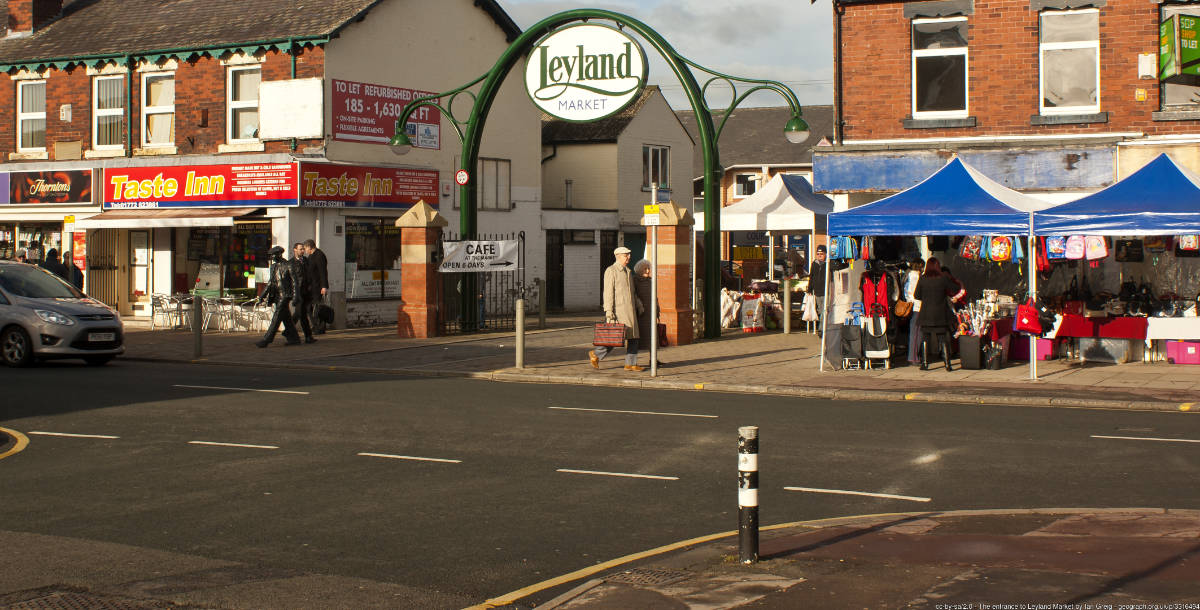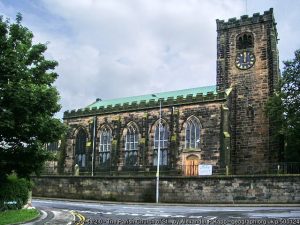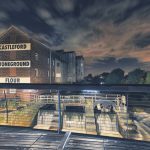
Looking for the ideal day trip for you and the fam? Leyland in Lancashire is a jewel in the north.
Sometimes nicknamed Leyland in Preston, Leyland in Lancashire is a gem of South Ribble. Formerly a famous cotton and coal town, Leyland is one of the many Lancashire industrial settlements which powered growth in the north of England. The modern town sits just ten miles from Preston, on an old Roman road. Leyland is famous for motor manufacturing, but there is far more to it than that.
Here is everything you need to know to plan a visit to Leyland. Join us for another travel guide so you can plan what to do when you get there.
Early History of Leyland
An ancient road runs through this area which the Romans built. Historians and metal detectorists have uncovered Roman coins in the region, proving that they were here. Asides from being on the Roman Road, early town records show that the village was split into three ploughland areas in the days before 1066.
The large stone cross in town dates to Saxon times, showing that the town was settled already before the Norman invasion and after the Roman one.
Leyland in the Domesday Survey
We are lucky with Leyland. The last few Lancashire towns we reported back on didn’t have an entry in the Domesday survey. When William the Conqueror arrived in England, he didn’t really know what it was he had conquered. After 20 years of wresting control of the country from the natives, he finally got his servants to document the lands so that he could accurately appoint taxes. Lancashire was still under hazy control at that point. Northern towns did not go quietly. Fortunately, Leyland was one of the Lancashire towns listed under Cheshire in the survey.
During the time of the Domesday survey, Leyland had 27 houses and 4 landowners. All four of the landowners are Roger of Poitou. Roger Montgomery, or Roger of Poitou, was a close advisor of William the Conqueror. The conquest of England made him an excessively rich man. In this town alone he owned:
- 3 woodlands of over 6 leagues
- Land worth 19 pounds, 17 shillings, and 12 pence
- 8 plough teams
- 14 villagers, 6 smallholders, 1 priest (and his church), 2 (other) and 4 riders.
He collected rent of 2 pounds and 8 shillings every year. That was a princely sum back then even if it sounds a little paltry nowadays.
The Medieval Era in Leyland
The oldest building in town is St Andrews Parish Church. The church opened in the 1200s but probably replaced an earlier building. That the town was large enough to require a parish church back then says a lot about
By 1206, Roger left some of the lands as a gift to a man named Robert Bussel. He built a manor at Leyland and remained there until 1242. Where manors and castles were, towns grew up. People flocked to the manor houses to work on the estates or to live in the owned villager cottages. The manor passed to William Farington, who died in 1610. During the civil war, the owner of the manor – Farington’s grandson William – fought by the Sheriff’s side. Once called Shaw’s Hall, the manor is known as Worden now. Many areas of the town are named for it.
Local council records show a Hearth Tax was placed on two large houses in the town in 1666. One of the houses belonged to William Farington, whose house had 23 occupants. The hearth tax charged homeowners a shilling per fireplace within their house. The king collected it twice a year. Many residents would shore up their fireplaces to avoid paying it.
Before the Domesday era, the entire area of Leyland is mentioned as being in possession of King Edward the Confessor. As of the 1200s it fell under the banner of Penwortham. There were three main landowners, later became Roger de Poitou. The town formed of 9 oxgangs, each later to have a representative that helped run the town.
Fun Facts About Leyland in Lancashire
During every travel guide of every town in Britain, we always pause for effect right about now. History can be overwhelming and the last thing we want to do is whelm you too much. Here are the best bits of gossip we could pick up about Leyland to break up all that whelming:
- Leyland probably began as a stopping point on the Roman road between Wigan and Walton-le-Dale. Troops may have passed through here on the way north to expand the borders into Scotland… and eventually, build a wall.
- Leyland is famous for Leyland Motors, the company that began in the 1950s and has been making trucks and buses ever since.
- ‘Leyland’ derives from Lailand, which combines two Old English words and means ‘untilled land’. The area was derived from three distinct ploughland, as recorded pre-Domesday survey.
- Leyland is also a family name associated with the town. You can read more about the family name Leyland here.
- Leyland also gives its name to a type of Cypress tree. The Leyland Cypress comes from crossing an Alaska Cedar with a Monterey Cypress. All this means to us is that somehow the name Leyland made it to America.
- There is an Ashok Leyland automobile company in India which began in 1948. Coincidence? You decide.
And on that slightly conspiratorial note, let the whelming resume. We will return to the village of Leyland just before it gained town status. The industrial revolution opened several cotton mills in the area, making it a hive of production.
Industrial Era Leyland
As with all Lancashire towns, Leyland truly grew wings during the industrial period. As the town grew, so too did the need to celebrate it. The Leyland Festival started all the way back in 1889 and it continued right up until the 1950s. There is some wonderful footage of factory workers leaving the mills in Leyland and walking home. The footage dates to 1900. You can spy it courtesy of the British Film Institute.
In 1887, the town council restored the old village cross as part of a Jubilee celebration. Leyland was a hive of industry during this time. The town produced woven cloth, particularly cotton, which was shipped around the country. The cotton woven using the cotton mills in Leyland and throughout Lancashire came from America. We cannot grow cotton in this country. Slaves would pick it and wealthy American landowners would trade it to wealthy British landowners. They would build mills and make a profit off the poor. Right up until 1911, Lancashire had 129,411 cotton mills. Admittedly only a few of those were in Leyland.
Modern Leyland
By 1901 Leyland had a population of 6,885 people. Recent years and the advancement of the motor manufacturing industry drove a population increase.
Since the 1890s, Leyland has played home to Leyland Motors. The bus and truck manufacturers are famous for incorporating Standard-Triumph, Rover, and other British motoring brands back in the 50s and 70s. Leyland Motors are still producing vehicles to this day, supplying hundreds of jobs in town. In 1968 it became the British Leyland Motor Corporation. Nowadays it goes by the name Leyland Trucks Ltd.
Modern Leyland has a total population hovering around 35,000 people. Situated only ten miles south of Preston, it offers city workers a place to live and commute to work. A new Tesco opened in 2002 and new housing opened in 2006. Other industry includes a Dr Oetker’s factory and Enterprise PLC.
The town is a happy commuter town that is one part ancient and one part modern. It keeps some beautiful old features and combines them with a unique industrial heritage that revolves around building vehicles. The town has plenty of lovely parkland and many attractions that make it a quaint place to live. Leyland is a cool place to live and a cool place to visit. Let’s review some of the best things to see and do there, right after we talk about celebrity guest appearances.
Famous People from Lancashire
Leyland has its own variety of famous people. If you want to go celebrity spotting, here are some of the names you should look out for:
- Several footballers – every northern town has footballers. Those that live in Leyland include Phil Jones, Clarke Carlisle, Fred Beardsworth, Liv Cooke, Danny Mayor, Mike Salmon, and Frank Moss.
- Allen Hill, was one of the men who played in the first-ever cricket test.
- John Woodcock was from Leyland. He was executed by the Stuarts in 1646 as a catholic martyr. The Stuarts notoriously did not like Catholics. Just look at what they did to Mary Queen of Scots.
- The former leader of the Liberal Democrats, Tim Farron, went to Runshaw College.
- Chris Tuson, a rugby league player, was from here.
- Actor Mark Strange is a Leyland man. He was in IP Man 4, Redcon-1, and other films.
- Makeup artist and prosthetic make-up specialist Mark Coulier is from here.
Compared to other towns of a similar size, Leyland scores highly on the famous faces stakes. Whether you are passing through or visiting for a summer vacation, keep your eyes peeled for those celebs.
Top Attractions in Leyland
This is the part of the article that most people love best – the part where we explore the area. Here are all the locals’ favourite things to see and do in town. Take your time and enjoy them, the British economy needs all the help it can get.
Historic Sites

The oldest building in town is St Andrews Church. If you want a truly Lancashire historic site, then head to Hoghton Tower for the day. Experiences the walled gardens and epic grounds of this ancient manor. Rumoured to hold ghosts, Hoghton Tower often runs re-enactment events and jousting days. They have archery displays and spearmen. They offer tours, run a monthly farmer’s market, and generally offer an all-around good time.
Landmarks
Technically a shopping and retail feature, Leyland has been a market town since the mid-1800s. As a result, the market in Hough Lane is a thriving part of the community and a much-recognized local landmark. You can find wonderful gifts, trinkets, and everything from pants and socks to pumpkins here. It runs Tuesdays, Fridays, and Saturdays.
Galleries
You will find the local art gallery on Turpin Green Lane. The Centurion Art Gallery and picture framing shop have works from local and national artists available. Browse the paintings and consider taking some Leyland-based home décor away with you.
Museums
One of the best things to see and do in Leyland is to visit the British Commercial Vehicle Museum. You will find it on King Street. It holds detailed replicas of vehicles all the way from horses and carts right to modern public transport systems. You can sit inside carriages, enjoy real-life commercial trucks and advertising vans from the early 1900s, and take some epic pictures of vehicles that you don’t get to see very often. This place has tons of appeal to both kids and old folk, though it is fun for all ages.
Believe it or not, this little town has two museums. The other one is the South Ribble Museum and Exhibition Centre. If you are in town to see a show or an art exhibit, it may well be in this building. The centre has artefacts from all over the Ribble area. They have archaeological discoveries and lots of information on the town. They don’t get a lot of funding so give freely while you are there.
Sports
If you want to catch some football while you are here, you will find the youth team and a football club. The local youth team are Leyland BTR FC. If you want the adult team, you want the Leyland Albion FC.
If you are a rugby fan, Leyland set up Leyland Warriors RFC back in 1993. You can find out more about them here.
As with all northern and English towns, there are golf courses for miles. Leyland Golf Club are the local club, although if you are able and willing to travel farther afield you can get bigger and better results. Leyland is not too far from the high-end Duxbury Park Golf Course. There’s even a driving rant about 10 miles away called Whitestake Golf Driving Range.
Recreation
Antiquing is a favourite pass time here in England, and Lancashire does it so well. Visit the Old Corn Mill Antiques Centre if you would like to enjoy a day spent browsing the wares. You never know when a gem will show up and change your life. Incidentally, it’s inside one of the old corn mills, hence the name.
Another fun activity in Leyland is the Calmly Creative Craft Studio. This paint and pottery workshop encourages kids to get creative using their art supplies. Kids and adults alike can make pottery and clay creations to commemorate their trip to Leyland for all the days to come. It’s one of those fun places that you need to return to after a few days once your pottery is fired.
If you are looking for something to do in Leyland with the kids, check out the Play Pad Zone. This is a soft play centre designed with young parents in mind. Take the kids here and hang out for a while. Let them tire themselves out while you enjoy the café and meet other mums and dads. Make new friends among the people who suffer the same as you do. Parenthood is a wondrous thing, but it is also exhausting. Soft play centres like this really help you to loosen up a little.
Outdoor Attractions
Worden Park is just of Hough Lane and locals describe it as a hidden gem in Leyland. The park is on the edge of the town, leading out into the wilderness of the beautiful Lancashire countryside. Locals designed Worden park back in 1941, although Worden Hall which sits in the centre of it has occupied this land for hundreds of years. Worden Hall belonged to the Farington family if you can recall the history from earlier. Today, the hall has a walled kitchen garden, flowerbeds, and sculpted gardens, and the house has craft stores inside. It’s a lovely place to spend the afternoon.
We heartily recommend that you find the Walled Garden and stop for tea. This community-run project helps people with disabilities take part in something wonderful. This little hidden gem is another special part of Leyland that makes it such a treasure. It’s a charity-run organization that you can follow on Facebook.
Where to Eat in Leyland?
Leyland is better known for its McDonald’s than its fine dining. Nevertheless, where there are people there’s good eatin’. Check out the Hallmark Grill on Leyland Road, which have a varied menu with British roots. If you are looking for somewhere to stay while you are in Leyland, then the Farington Lodge Hotel in nearby Farington gets a good reputation for both food and accommodation. It’s named for the Farington family, local landowners for generations. You don’t get much more local than that. Of course, if all you want is a fish supper, you want Ocean’s Finest Fish and Chips.
Where to Drink in Leyland?
Leyland might not be party central, but it gives you a good night out. The flavour of the month here is the perfect pint, which you can find at either the Golden Tap, the Market Ale House, or the Queen’s, Leyland. There are also the Broadfield Arms, the Barristers Public House, and the Rose & Crown. The nearest nightclub is probably Blitz, in Preston.
Where to Shop in Leyland?
If you want to experience the best shopping that the area has to offer, you’d better head into nearby Preston for at least an afternoon during your stay. Otherwise, Leyland holds an array of modern stores that will provide you with your every need while you are here. There is Tesco, a Morrisons, a SPAR, they have The Range and a B&M Home Store. Add in an Argos and it sounds like the best British high street ever. You will find most shops in the town centre. Let’s not forget a special shout-out to Grandad Jim’s Traditional Sweet Shoppe because it is exactly as tempting as it sounds.
Other Notable Attractions
There is more than one way to swing a cat and there is more than one town in Lancashire. If you happen to spend more than a few days in the area, here are some other sites you should try to check out:
- Check out nearby Clitheroe Castle
- Take a day trip to Cramlington
- Visit the industrial town of Blyth
- Take a day trip to Chorley
- Spend the afternoon or evening enjoying Preston
- Make a day trip of it and go to Blackburn shopping
There is something to do no matter your age or interests here. Get out and about and explore if you run out of inspiration. You can even use the Five Minutes Spare page to help you.
How to get to Leyland?
We are almost at the end of this town guide to Leyland, and it has been a pleasure to serve you. Before you go, use these rough directions at your own risk.
By Road
Leyland is on the M6, follow it north or south.
By Rail
You can catch a train to Leyland station on the Northern Line.
By Air
You can fly to Liverpool or to Blackpool.
By Sea
There is no sea access to Leyland.
Got Five Minutes?
We love to review towns and cities, talk about new hobbies, and give our members a forum to air their views. However, we can’t do it if we don’t have visitors. Head over to our website and pay us a visit for more entertaining blogs. Alternatively, hop onto Facebook and drop us a follow. The more the merrier.


